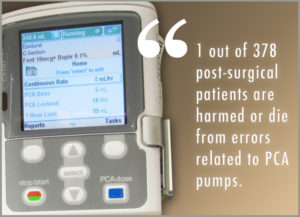Researchers at the University of Colorado Hospital recently reported that their use of a PCA safety checklist was found to reduce pain from moderate-severe pain to no-mild pain in 42% of patients within 2 days. In “Let’s Be Smart About Improving Pain,” they reported:
Our PCA safety checklist smart phrases increased use of a safety checklist and documentation of daily PCA opioid trends, and correlated with more rapid improvement in moderate-severe pain levels.
They used smart phrases in these four areas covering a patient’s continuum of care – PCA initiation, PCA titration, PCA transition to oral opioids, and PCA discharge handoff – to facilitate standardized documentation of PCA management.
The Physician-Patient Alliance for Health & Safety released a PCA Safety Checklist developed in conjunction with renowned medical experts, including intensive care specialist and a leader in medical checklist development Peter J. Pronovost, MD, PhD, FCCM, Professor, Departments of Anesthesiology/Critical Care Medicine and Surgery, The Johns Hopkins University School of Medicine and Medical Director, Center for Innovation in Quality Patient; and Atul Gawande, MD, Professor in the Department of Health Policy and Management at the Harvard School of Public Health, who is a surgeon at Brigham and Women’s Hospital Professor of Surgery at Harvard Medical School and author of “The Checklist Manifesto.”
“We would recommend that all patients receiving opioids be continuously electronically monitored,” said Michael Wong, JD (Founder and Executive Director, Physician-Patient Alliance for Health & Safety.
Please refer to the PPAHS position statement on continuous electronic monitoring for more information.
